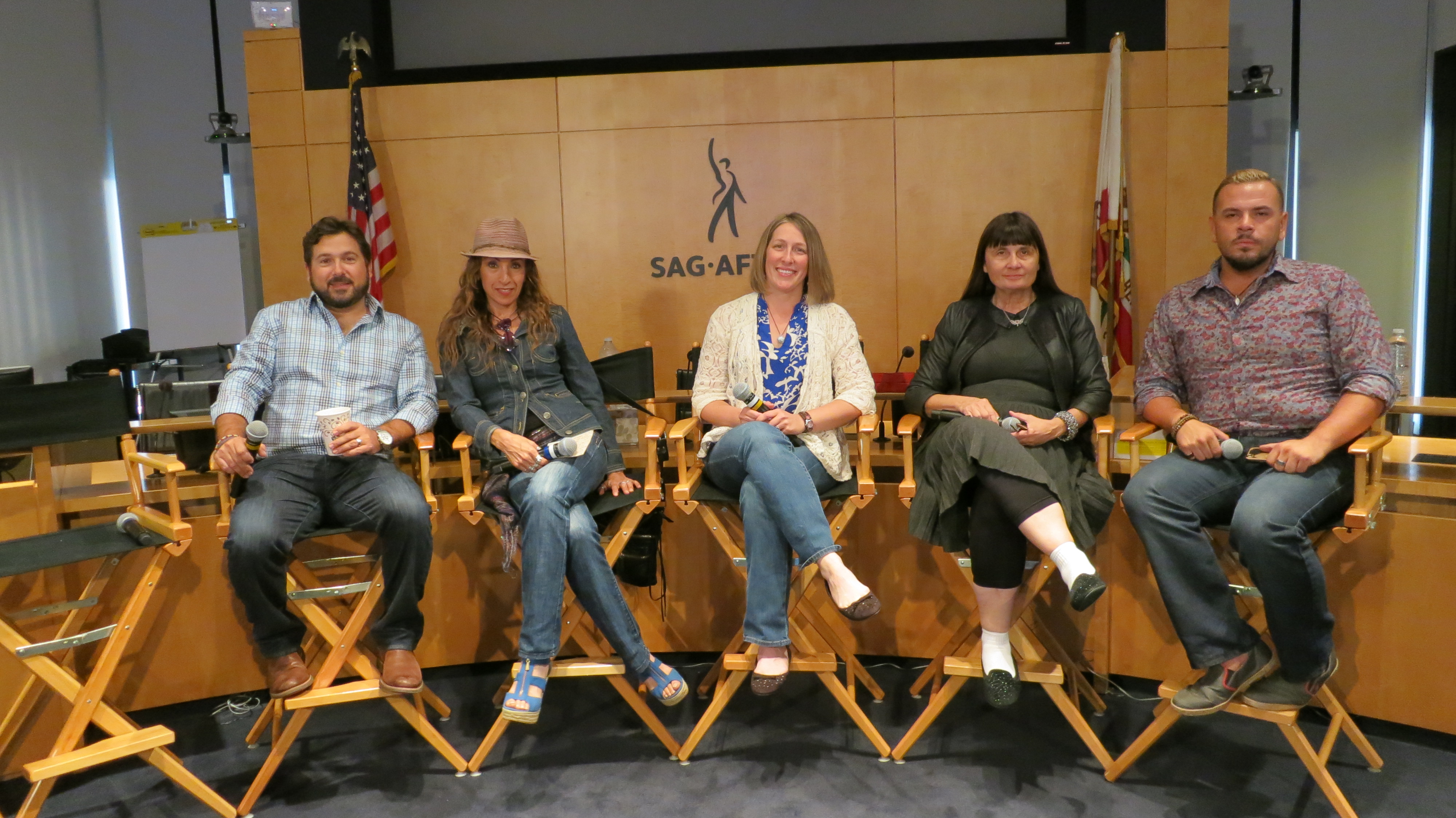First in a series of articles featuring SAG-AFTRA departments.
Since the very early days of cinema, audiences around the world have focused their gaze upon their favorite stars with barely a thought of those surrounding them.
Imagine the infamous chariot race in Ben Hur if Charlton Heston alone was riding a chariot and not accompanied by the 15,000 background actors in the scene. Or if only 20 actors were seen in the funeral scene of Richard Attenborough’s legendary Gandhi, instead of the 300,000 mourners portrayed by background actors.
Indeed, background artists are an integral and indispensable asset in films, television series and commercials. Whether dancing in the crowd, passengers on a train, patrons in a restaurant, guests at a wedding or members of a jury, background actors provide realism to a scene.
Frequently they are called upon to pantomime conversation and improvise background action for authenticity on screen. Some have specialized skills, including expert horsemanship, athletic abilities, magic, dancing, gymnastics, machinery operation or medical training.
In 1992, SAG and AFTRA jointly bargained recognition, terms and conditions for background performers under the former Screen Extra Guild jurisdiction. Since then, SAG-AFTRA has improved wages and working conditions for background actors in the TV/Theatrical contracts and created a department solely dedicated to these performers and their needs.
The SAG-AFTRA Background Actors Department provides interpretations and enforcement of the terms and conditions for background actors covered by the television and theatrical collective bargaining contracts. The team works closely with background actor members, production staff on film, television and commercial projects, and the studio labor relations departments to provide guidance and education.
The department team consists of seven dedicated staff members led by Fatna Sallak-Williams, who became director in February 2016. With more than 14 years of experience in labor relations, Fatna previously served as a business representative for SAG-AFTRA’s San Francisco office, a case manager for the Legal Department and as a senior manager of the SAG-AFTRA Theatrical Contracts Department. Throughout the years, she has interpreted, enforced and explained SAG-AFTRA collective bargaining agreement provisions to members, colleagues, signatory companies and all third parties involved with SAG-AFTRA-covered productions.
“It was very important to me to make a difference to the background actors by taking an active role in advocating their rights and supporting their needs,” explains Sallak-Williams. “Our members are my highest priority and it is paramount to me to provide them with all the resources they need to be successful and afford them experienced and knowledgeable contract experts empowered to answer their questions and file claims expeditiously.”

From left, casting director panelists Alice Ellis, Jeff Olan, Vanessa Portillo and Carol Grant
To accomplish this, Sallak-Williams and her team created a new, easy online program for members to submit their claims and implemented rapid turnarounds to monitor both claims and background actors’ Taft-Hartley processing. Click here for information on filing claims for background actors. To further member service, all calls and emails are returned within 24 hours.
In an effort to provide more comprehensive informational material to members, the department created multiple contract “cheat sheets” to help members understand their contractual rights under the multiple television and theatrical agreements, and updated the Background Actors Digest, a readily available resource, to answer the most frequently asked questions, including rates and working conditions applicable to the West and East Coast Background Actor Zones in theatrical motion pictures and television. Click here for L.A. zones.
To help better prepare SAG-AFTRA members who work as background actors, the Background Actors and Education Committee, along with the SAG-AFTRA Background Actors Department, hosted three events offering members the chance to hear directly from their peers, casting directors, costumers, hair and makeup artists, and production personnel, including the all-important assistant directors.
In May, the comprehensive seminar Background 101 launched the series, which aims to support and educate background actor members. Background actor Rick Markman and other seasoned professional performers provided pertinent information on how to become a valuable addition to the cast. They covered learning on-set etiquette and navigating the SAG-AFTRA website to locate show sheets, contracts rates and FAQs. SAG-AFTRA National Director, Specialty Performers Terri Becherer joined Sallak-Williams for an in-depth presentation of background actors’ contractual rights under the SAG-AFTRA Television and Theatrical contracts, including the Network TV Code, Comedy Central and Nickelodeon contracts. She also explained how to file a claim if problems arise.
An Evening with Casting Directors held in July and moderated by Sallak-Williams, featured Alice Ellis, Carol Grant, Jeff Olan and Vanessa Portillo as panelists. A lively discussion ensued with the CDs explaining the process they go through when casting background actors and how the requirements have changed throughout the years. Where previously productions would tell the CDs how many people they needed and what the action was, today’s producers, directors and advertising agencies want more input and ask for pictures of proposed background actors before casting them. In some cases, where background actors might be in action close to lead talent, interviews are often requested.
Being Camera Ready, held in August, gave members the opportunity to engage with assistant directors from the DGA, a costumer from the Motion Picture Costumers IATSE Local 705, and a makeup artist and hair stylist from the Makeup Artists & Hair Stylist Guild IATSE Local 706.

From left, Camera Ready panelists Assistant Director Erik J. Carpenter, Makeup Artist Cinzia Zanetti, Assistant Director Michelle Gritzer, Costumer Nancy Grossi and Hair Stylist Pavy Olivarez
The panelists, including assistant directors Erik J. Carpenter and Michelle Gritzer, Costumer Nancy Grossi, Hair Stylist Pavy Olivarez and Makeup Artist Cinzia Zanetti, provided valuable insights and suggestions on what it means to be “camera-ready” from the dressing room to the set.
Carpenter and Gritzer presented an overview of the DGA structure, outlining the various responsibilities of each member of the directorial team, what the director expects from background actors and how to best work with production assistants and assistant directors. Grossi, Zanetti and Olivarez offered tips on how to show up prepared and ready to step in front of the camera.
Sallak-Williams reminds all background actors, “Stay positive, be enthusiastic and professional at all times and remember you are an essential part of the production, for without your performance a scene would be pretty empty, not to mention unrealistic.”
If you are an actor working background, the Background Actors Department is always here to help you. It is your resource for any problems that arise on set, whether issues can be resolved quickly without a claim or if a formal claim is necessary. If you have specific questions or concerns, you are always front and center to Sallak-Williams and her team.
Valuable Tips for Background Actors
To help members be prepared when working as background actors, casting directors and production personnel offer a range of helpful tips and advice, including:
YOUR LOOK
* Look like your picture! Often you are chosen for the look you represent — don’t use an old picture. Did you change hairstyles or have a weight change? Keep your photo up to date and your casting agencies informed.
* Stay true to your look. If you have a Mohawk and dress like punk rocker, don’t submit for a business role. If you look like you could be in the business world, you should own business suits, nice casual and cocktail attire. Workout and athletic clothing is great to have in your arsenal, just remember to avoid logos. If you have a specific look, play to it. The more range you have the more options will be available to you.
SKILLS AND ABILITIES
* Can you play an instrument, perform magic tricks or juggle? Are you a certified EMT, a nurse or professional sushi chef? If so, be sure to list these special skills on your resume or registration information with casting agencies.
* If you are asked to perform a special skill not originally called for in your booking (such as wet or smoke work), contact the casting agency immediately. Often they can resolve the problem that day by quickly adjusting your fees and contract, where a formal claim could take weeks to reach production and often, particularly in a commercial shoot, happens long after the production has wrapped.
WARDROBE
* The wardrobe department is usually the first to see you on set, so come prepared with the requested clothing, clean and pressed.
* Upon arrival, take off hats and sunglasses so the wardrobe, hair and makeup departments can see who you are. First impressions are key. Remember, hair and makeup personnel have limited time to go through the line and will pick those actors most prepared with “the look” required.
* Think different color pallets and muted colors. Avoid red, all white or small patterns. If you have period-specific clothing or Western clothing, you’ll be more able to submit for projects that have such specific needs. Shop thrift and consignment stores and you’ll find all sorts of affordable options to keep in your closet.
* If you are called for multiple days, bring several different changes. But if you are in the same scene shot across several days, be sure you wear exactly the same clothing.
* Pay most attention to your bottom half. Wear pants or skirts and shoes that you know fit and are comfortable. It’s easy for wardrobe to provide you with a jacket, sweater or different tie. For women, if you are called to appear onscreen in heels, bring a pair of folding ballet flats for when you are not working. Your feet will thank you! And, above all, bring only “quiet” shoes!
* Essential wardrobe: Black pants, dress shirts, basic professional business attire, formal and cocktail wear, nice casual, and sports or workout clothing are all good basics to have on hand. Unless instructed otherwise, don’t bring the most expensive-looking suit you own; you want to blend in to the background, not outshine the star.
MAKEUP AND HAIR
* Wear natural base foundation when arriving on set. Women should bring four choices of lipstick (red, rose, beige and burgundy), pressed powder, neutral eye shadow, blotting paper and concealer. Men should be clean-shaven, unless instructed otherwise, and bring a disposable razor.
* Accuracy is important in period productions, and background actors often set the scene. So, do your research. Pay attention to the details of season and locality cited in your instructions. If it’s fall 1956 in Washington, D.C., your clothing will be different than the same period in Florida. Remember, too, in period productions, hair styles and colors were very different than they are today. If your hair is highlighted or streaked, the hair department may have to cover it. But don’t worry — anything they use will wash out!
* If you have allergic reactions to hair or skin products, be sure and advise the AD upon checking in. Feel free to bring your own non-allergic products to the hair and makeup trailer.
* Wigs are not hats, so if you are fitted in a wig, do not take it off when you are off camera. Be mindful if your hair is styled or set. To the hair department, your hair is not yours on set — it’s theirs! If you find a wig uncomfortable in any way, talk to the hair stylists and they will help you.
GENERAL
* Use caution with your use of social media. Posting information on the production is an absolute taboo, and under no circumstances should you post any pictures from the set. Many productions do not allow cell phones on set at all.
* Remember, every department you encounter has influence over your being brought back.
* When the AD is giving instructions, pay close attention to the details given. Know your crosses and your cues. Continuity is vital.
* Nothing is more important on set than being on time, dependable, enthusiastic and a team player.
News
- Tags:
- Local News
